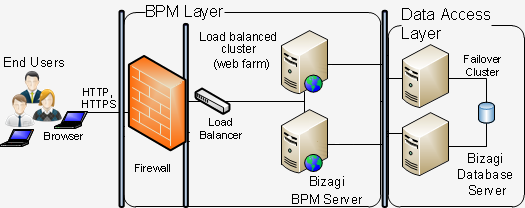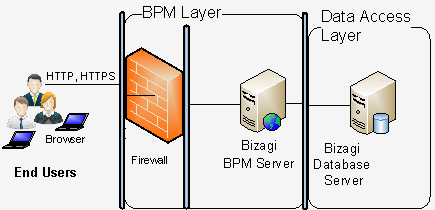Hardware and Software Requirements Enterprise .NET
From Business Process Management, BPM and Workflow Automation Wiki | BizAgi BPMS
<keywords content="keywords"> system requirements, development requirements, test requirements, environment, standard edition, hardware, software requirements, hardware requirements, enterprise edition, enterprise .net edition, enterprise, enterprise .net, .net </keywords>
|
Applies to ENTERPRISE .NET EDITION |
Contents |
Bizagi Enterprise .Net system requirements
The following requirements correspond to Bizagi's Enterprise .Net edition approach and features.
View the article about the differences between Bizagi editions or Bizagi editions' features comparison table.
Production environment
In the Production environment, Bizagi can be set up with the following recommended minimum requirements for 2 main scenarios:
- Mission Critical: This scenario and infraestructure set up uses a BPM cluster and a database cluster, and it is designed for those business applications and services which are expected to be available all the time (high availability).
- Standard Scenario: This scenario uses a single BPM server and a single database server (no load balancing and fault tolerance needed).
For any of the 2 scenarios it is strongly recommended to use the Bizagi Enterprise .Net for 64-bits version.
Note: When using the 64-bit Bizagi Enterprise .NET edition, it is required to use IIS.
Mission Critical (High Availability)
To support a high performance and availability of Bizagi's solution, this scenario involves additional servers (cluster configuration), for load balancing in the BPM server, and fault tolerance in the Database server).
|
Note: While using a clustered BPM Server (in this scenario), it is required to configure the use of Sticky Sessions in the load balancer.
The configuration for Sticky Sessions use differs according to the software or hardware employeed as load balancer.
|
| Number of BPM Servers: 2 (with load balance cluster configuration). | |||
|
BPM Server | HARDWARE | NUMBER OF PROCESSORS | |
|---|---|---|---|
| PROCESSOR | | ||
| RAM | | ||
| HARD DISK | | ||
| ADDITIONAL DEVICES | | ||
| SOFTWARE | OPERATING SYSTEM | | |
| WEB SERVER | | ||
| ADDITIONAL COMPONENTS | | ||
| Number of Database Servers: 2 (with failover cluster configuration). | |||
|
Database Server | HARDWARE | NUMBER OF PROCESSORS | |
|---|---|---|---|
| PROCESSOR | | ||
| RAM | | ||
| HARD DISK | | ||
| ADDITIONAL DEVICES | | ||
| SOFTWARE | DATABASE ENGINE | It is required that the Database engine version, service pack, and collation installed in the Production environment corresponds to the same one as the one installed in the Development environment. | |
Additional Information
Take into account that the hardware requirements for a Production environment will also depend on other variables such as: the number of concurrent users, the processing demands, the expected database and file growth, amongst others.
Therefore, the recommended minimum requirements and configurations presented in this article may be complemented by carrying out an analysis related to the sizing of the specific project (for hardware dimension).
For instance, this includes defining the number of additional BPM servers (web farm) for the solution.
To view and obtain a sizing estimation for your project, you may use our Bizagi Sizing Estimator.
Standard Scenario
In this scenario a single BPM server and a single database server is used.
| Number of BPM Servers: 1. | |||
|
BPM Server | HARDWARE | NUMBER OF PROCESSORS | |
|---|---|---|---|
| PROCESSOR | | ||
| RAM | | ||
| HARD DISK | | ||
| ADDITIONAL DEVICES | | ||
| SOFTWARE | OPERATING SYSTEM | | |
| WEB SERVER | | ||
| ADDITIONAL COMPONENTS | | ||
| Number of Database Servers: 1. | |||
|
Database Server | HARDWARE | NUMBER OF PROCESSORS | |
|---|---|---|---|
| PROCESSOR | | ||
| RAM | | ||
| HARD DISK | | ||
| ADDITIONAL DEVICES | | ||
| SOFTWARE | DATABASE ENGINE | It is required that the Database engine version, service pack, and collation installed in the Production environment corresponds to the same one as the one installed in the Development environment. | |
Take into account that the hardware requirements for a Production environment will also depend on other variables such as: the number of concurrent users, the processing demands, the expected database and file growth, amongst others.
Therefore, the recommended minimum requirements and configurations presented in this article may be complemented by carrying out an analysis related to sizing of the specific project (for hardware dimension).
Production environment with Internet Access
For projects in which end users need to access the work portal via internet, an optional Apache Server can be configured as a reverse proxy in a DMZ, in order to allow secure internet access to Bizagi's projects:
View further information about how to set up Bizagi for secure Internet Access through a reverse proxy in a DMZ.
Development environment
In the Development environment (a construction phase of the project), Bizagi can be set up with the following recommended minimum requirements, and in a way that team work is supported for the whole project team:
| Number of BPM Servers: 1. | |||
|
BPM Server | HARDWARE | NUMBER OF PROCESSORS | |
|---|---|---|---|
| PROCESSOR | | ||
| RAM | | ||
| HARD DISK | | ||
| SOFTWARE | OPERATING SYSTEM | | |
| WEB SERVER | | ||
| ADDITIONAL COMPONENTS | | ||
| Number of Database Servers: 1. | |||
|
Database Server | HARDWARE | NUMBER OF PROCESSORS | |
|---|---|---|---|
| PROCESSOR | | ||
| RAM | | ||
| HARD DISK | | ||
| SOFTWARE | DATABASE ENGINE | | |
|
Bizagi Studio user | HARDWARE | PROCESSOR | |
|---|---|---|---|
| RAM | | ||
| HARD DISK | | ||
| SCREEN RESOLUTION | | ||
| SOFTWARE | OPERATING SYSTEM | | |
| BROWSER | | ||
| ADDITIONAL COMPONENTS | |
View more information about the team work possibility in a Bizagi project.
Test environment
In the Test environment, Bizagi can be set up with the following recommended minimum requirements as illustrated below:
| Number of BPM Servers: 1. | |||
|
BPM Server | HARDWARE | NUMBER OF PROCESSORS | |
|---|---|---|---|
| PROCESSOR | | ||
| RAM | | ||
| HARD DISK | | ||
| SOFTWARE | OPERATING SYSTEM | | |
| WEB SERVER | | ||
| ADDITIONAL COMPONENTS | | ||
| Number of Database Servers: 1. | |||
|
Database Server | HARDWARE | NUMBER OF PROCESSORS | |
|---|---|---|---|
| PROCESSOR | | ||
| RAM | | ||
| HARD DISK | | ||
| SOFTWARE | DATABASE ENGINE | It is required that the Database engine version, service pack, and collation installed in the Test environment corresponds to the same one as the one installed in the Development environment. | |
Take into account that the hardware requirements for a Test environment should be as similar as possible to the Production environment servers' specifications in order to properly test the processes behaviour and performance.
Other Editions
Related Articles
<comments />





